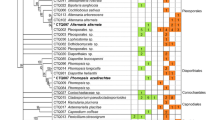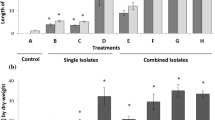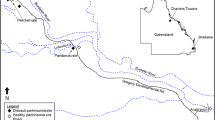Abstract
Phytophthora species have caused the decline and dieback of multiple tree species in Australia and around the world. Dieback in invasive trees in Australia has been observed for decades, motivating research into the potential causes of dieback to be used for biological control of these invasive species. Despite wide-ranging and ongoing research into invasive plant dieback, Phytophthora species have been largely ignored as potential causal agents of dieback, with the focus more on latent fungal pathogens living as endophytes. We conducted the first survey of Phytophthora and other oomycetes to determine their association with dieback of the invasive tree, Parkinsonia aculeata L. (Fabaceae). Using zoospore baiting, we recovered 37 oomycete isolates from roots and soil of healthy and dieback-affected P. aculeata in Kununurra, Western Australia and Charters Towers, Queensland. Using molecular taxonomy, we identified ten unique oomycete taxa, predominantly composed of Phytophthora palmivora, Ph. nicotianae and Phytopythium vexans. Parkinsonia dieback occurs across multiple climatic zones including those experiencing severe drought. We recovered fewer oomycete isolates from soil and roots in drought-affected Charters Towers than Kununurra, which had experienced recent rainfall. This may be because oomycetes require soil moisture for the dispersal of zoospores. None of the genotypes identified were consistently isolated from dieback-affected trees suggesting that any association with parkinsonia dieback may be localised. More extensive surveys and pathogenicity screenings of isolated oomycetes are required to evaluate their role in the parkinsonia dieback phenomenon.



Similar content being viewed by others
References
Aghighi S, Burgess TI, Scott JK, Calver M, Hardy GESJ (2016) Isolation and pathogenicity of Phytophthora species from declining Rubus anglocandicans. Plant Pathol 65:451–461. doi:10.1111/ppa.12436
Agrios GN (2005) Plant pathology. Elsevier Academic Press, Burlington
Ashby SF (1928) The oospores of Phytophthora nicotianae Br. De Haan, with notes on the taxonomy of P. parasitica Dastur. Trans Br Mycol Soc 13:86–95. doi:10.1016/S0007-1536(28)80007-6
Brasier C, Webber J (2010) Plant pathology: sudden larch death. Nature 466:824–825. doi:10.1038/466824a
Brasier C, Robredo F, Ferraz J (1993) Evidence for Phytophthora cinnamomi involvement in Iberian oak decline. Plant Pathol 42:140–145. doi:10.1111/j.1365-3059.1993.tb01482.x
Brasier C, Denman S, Brown A, Webber J (2004) Sudden oak death (Phytophthora ramorum) discovered on trees in Europe. Mycol Res 108:1108–1110. doi:10.1017/S0953756204221244
Bureau of Meteorology (2016) Climate statistics for Australian locations. Australian Government http://www.bom.gov.au/climate/
Ciesla WM, Donaubauer E (1994) Decline and dieback of trees and forests. Rome, Food and Agriculture Organization of the United Nations
Cline ET, Farr DF & Rossman AY (2008) A synopsis of Phytophthora with accurate scientific names, host range, and geographic distribution. Plant Health Prog doi:10.1094/PHP-2008-0318-01-RS
de Cock A, Lodhi AM, Rintoul TL, Bala K, Robideau GP, Abad ZG, Coffey MD, Shahzad S, Lévesque CA (2015) Phytopythium: molecular phylogeny and systematics. Persoonia 34:25–39. doi:10.3767/003158515X685382
Cooke DEL, Drenth A, Duncan JM, Wagels G, Brasier CM (2000) A molecular phylogeny of Phytophthora and related oomycetes. Fungal Genet Biol 30:17–32. doi:10.1006/fgbi.2000.1202
Dell B, Malajczuk N (1989) Jarrah dieback — a disease caused by Phytophthora cinnamomi. In: Dell B, Havel JJ, Malajczuk N (eds) The jarrah Forest: a complex mediterranean ecosystem. Springer Netherlands, Dordrecht, pp 67–87
Diplock ND (2016) Parkinsonia dieback: investigations into its cause, ecology and potential for biological control. The University of Queensland, Dissertation
Erwin DC, Ribeiro OK (1996) Phytophthora diseases worldwide. APS Press, St Paul
Farr DF, Bills GF, Chamuris GP & Rossman AY (1989) Fungi on Plants and Plant Products in the United States. APS Press, Minnesota
Garbelotto M, Hayden KJ (2012) Sudden oak death: interactions of the exotic oomycete Phytophthora ramorum with naïve north American hosts. Eukaryot Cell 11:1313–1323. doi:10.1128/EC.00195-12
Gardes M, Bruns TD (1993) ITS primers with enhanced specificity for basidiomycetes--application to the identification of mycorrhizae and rusts. Mol Ecol 2:113–118. doi:10.1111/j.1365-294X.1993.tb00005.x
Haque A (2015) Investigation of the fungi associated with dieback of prickly acacia (Vachellia nilotica subsp. indica) in northern Australia. Dissertation, the University of Queensland.
Hüberli D, Tommerup IC, Hardy GES (2000) False-negative isolations or absence of lesions may cause mis-diagnosis of diseased plants infected with Phytophthora cinnamomi. Australas Plant Pathol 29:164–169. doi:10.1071/AP00029
Judelson HS, Blanco FA (2005) The spores of Phytophthora: weapons of the plant destroyer. Nat Rev Microbiol 3:47–58. doi:10.1038/nrmicro1064
Kageyama K, Nakashima A, Kajihara Y, Suga H & Nelson EB (2005) Phylogenetic and morphological analyses of Pythium graminicola and related species. J Gen Plant Pathol 71:174-182. doi:10.1007/s10327-005-0184-5
Kaosiri T, Zentmyer GA, Erwin DC (1980) Oospore morphology and germination in the Phytophthora palmivora Complex from cacao. Mycologia 72:888–907. doi:10.2307/3759732
van Klinken RD, Flack LK, Pettit W (2006) Wet-season dormancy release in seed banks of a tropical leguminous shrub is determined by wet heat. Ann Bot 98:875–883. doi:10.1093/aob/mcl171
van Klinken RD, Campbell SD, Heard TA, McKenzie J, March N (2009) The biology of Australian weeds: Parkinsonia aculeata L. Plant Prot Q 24:100–117
Ko WH (2003) Long-term storage and survival structure of three species of Phytophthora in water. J Gen Plant Pathol 69:186–188. doi:10.1007/s10327-003-0033-3
Manion PD, Lachance D (1992) Forest decline concepts: an overview. In: Manion PD, Lachance D (eds) Forest decline concepts. St. Paul, The American Phytopathological Society, pp 181–190
Middleton JT (1943) The taxonomy, host range and geographic distribution of the genus Pythium. Mem Torrey Bot Club 20:1-171.
Mueller-Dombois D (1987) Natural dieback in forests. Bioscience 37:575–583. doi:10.2307/1310668
Newhook F, Podger F (1972) The role of Phytophthora cinnamomi in Australian and New Zealand forests. Annu Rev Phytopathol 10:299–326. doi:10.1146/annurev.py.10.090172.001503
Otrosina W & Marx D (1975) Populations of Phytophthora cinnamomi and Pythium spp. under shortleaf and loblolly pines in little leaf disease sites. Phytopathol. doi:10.1094/Phyto65_1224
Pautasso M, Aas G, Queloz V, Holdenrieder O (2013) European ash (Fraxinus excelsior) dieback - a conservation biology challenge. Biol Conserv 158:37–49. doi:10.1016/j.biocon.2012.08.026
Polat Z, Awan QN, Hussain M & AkgÜL DS (2017) First report of Phytopythium vexans causing root and collar rot of kiwifruit in Turkey. Plant Dis doi:10.1094/PDIS-11-16-1554-PDN
Pratt B, Heather W (1973) The origin and distribution of Phytophthora cinnamomi Rands in Australian native plant communities and the significance of its association with particular plant species. Aust J Biol Sci 26:559–574. doi:10.1071/BI9730559
Raghavendra AKH, Bissett AB, Thrall PH, Morin L, Steinrucken TV, Galea VJ, Goulter KC, van Klinken RD (2017) Characterisation of above-ground endophytic and soil fungal communities associated with dieback-affected and healthy plants in five exotic invasive species. Fungal Ecol 26:114–124. doi:10.1016/j.funeco.2017.01.003
Rea AJ, Jung T, Burgess T, Stukely MJC, Hardy GESJ (2010) Phytophthora elongata sp. nov., a novel pathogen from the Eucalyptus marginata forest of Western Australia. Australas Plant Pathol 39:477–491. doi:10.1111/ppa.12436
Rizzo DM, Garbelotto M (2003) Sudden oak death: endangering California and Oregon forest ecosystems. Front Ecol Environ 1:197–204. doi:10.2307/3868064
Robideau GP, de Cock AWAM, Coffey MD, Voglmayr H, Brouwer H, Bala K, Chitty DW, Désaulniers N, Eggertson QA, Gachon CMM, Hu C-H, Küpper FC, Rintoul TL, Sarhan E, Verstappen ECP, Zhang Y, Bonants PJM, Ristaino JB & Lévesque CA (2011) DNA barcoding of oomycetes with cytochrome c oxidase subunit I and internal transcribed spacer 11, 1002–1011. doi:10.1111/j.1755-0998.2011.03041.x
Sacdalan A (2015) Mimosa pigra dieback in the northern territory. Investigation into possible causes. Dissertation, The University of Queensland, Australia
Scott P, Burgess T, Hardy GESJ (2013) Globalization and Phytophthora. In: Lamour K (ed) Phytophthora: a global perspective. CAB International, Wallingford, pp 226–232
Spies CFJ, Mazzola M, McLeod A (2011) Characterisation and detection of Pythium and Phytophthora species associated with grapevines in South Africa. Eur J Forest Pathol 131:103. doi:10.1007/s10658-011-9791-5
Steinrucken TV, Bissett A, Powell JR, Raghavendra AKH, van Klinken RD (2016) Endophyte community composition is associated with dieback occurrence in an invasive tree. Plant Soil 405:311–323. doi:10.1007/s11104-015-2529-y
Steinrucken TV, Raghavendra AKH, Powell JR, Bissett A, van Klinken RD (2017) Triggering dieback in an invasive plant: endophyte diversity and pathogenicity. Australas Plant Pathol 46:157–170. doi:10.1007/s13313-017-0472-5
Templeton GE, Greaves MP (1984) Biological control of weeds with fungal pathogens. Trop Pest Manage 30:333–338. doi:10.1080/09670878409370907
Tewoldemedhin YT, Mazzola M, Botha WJ, Spies CFJ, McLeod A (2011) Characterization of fungi (Fusarium and Rhizoctonia) and oomycetes (Phytophthora and Pythium) associated with apple orchards in South Africa. Eur J Forest Pathol 130:215–229. doi:10.1007/s10658-011-9747-9
Thorp JR, Lynch R (2000) The determination of the weeds of National Significance. National Weeds Strategy Executive Committee, Launceston
Toh R (2009) Investigation of fungi pathogenic towards seedlings of Parkinsonia aculeata – their potential for use as mycoherbicides. The University of Queensland, Dissertation
Uzuhashi S, Tojo M, Kakishima M (2010) Phylogeny of the genus Pythium and description of new genera. Mycoscience 51:337–365. doi:10.1007/s10267-010-0046-7
Valencia AL, Chorbadjian RA & Latorre BA (2011) First Report of Nothofagus macrocarpa Dieback Caused by Phytophthora citrophthora and P. nicotianae in Chile. Plant Dis 95:1193-1193. doi: 10.1094/pdis-03-11-0258
Vawdrey LL, Langdon P, Martin T (2005) Incidence and pathogenicity of Phytophthora palmivora and Pythium vexans associated with durian decline in far northern Queensland. Australas Plant Pathol 34:127–128. doi:10.1071/ap04093
Vega FE, Simpkins A, Aime MC, Posada F, Peterson SW, Rehner SA, Infante F, Castillo A, Arnold AE (2010) Fungal endophyte diversity in coffee plants from Colombia, Hawai'i, Mexico and Puerto Rico. Fungal Ecol 3:122–138. doi:10.1016/j.funeco.2009.07.002
Vilgalys R (2003) Taxonomic misidentification in public DNA databases. New Phytol 160(1):4–5. doi:10.1046/j.1469-8137.2003.00894.x
Widmer T, Graham J, Mitchell D (1998) Histological comparison of fibrous root infection of disease-tolerant and susceptible citrus hosts by Phytophthora nicotianae and P. palmivora. Phytopathology 88:389–395. doi:10.1094/Phyto.1998.88.5.389
Acknowledgements
This research is funded by Meat and Livestock Australia via a technical assistance grant (for TVS; B.STU.0271). TVS is also supported by the Australian Government via an Australian Post-graduate Award and the Hawkesbury Institute for the Environment at Western Sydney University. The authors would like to thank Kay Bailey (WA Agriculture) and Kelli Pukallus (Biosecurity Queensland) for fieldwork, Briony Williams (Murdoch University) for help with isolations, and Kylie Ireland, Louise Morin (CSIRO) and two anonymous reviewers for their helpful comments which greatly improved this paper.
Author information
Authors and Affiliations
Corresponding author
Rights and permissions
About this article
Cite this article
Steinrucken, T.V., Aghighi, S., Hardy, G.E.S.J. et al. First report of oomycetes associated with the invasive tree Parkinsonia aculeata (Family: Fabaceae). Australasian Plant Pathol. 46, 313–321 (2017). https://doi.org/10.1007/s13313-017-0494-z
Received:
Accepted:
Published:
Issue Date:
DOI: https://doi.org/10.1007/s13313-017-0494-z




